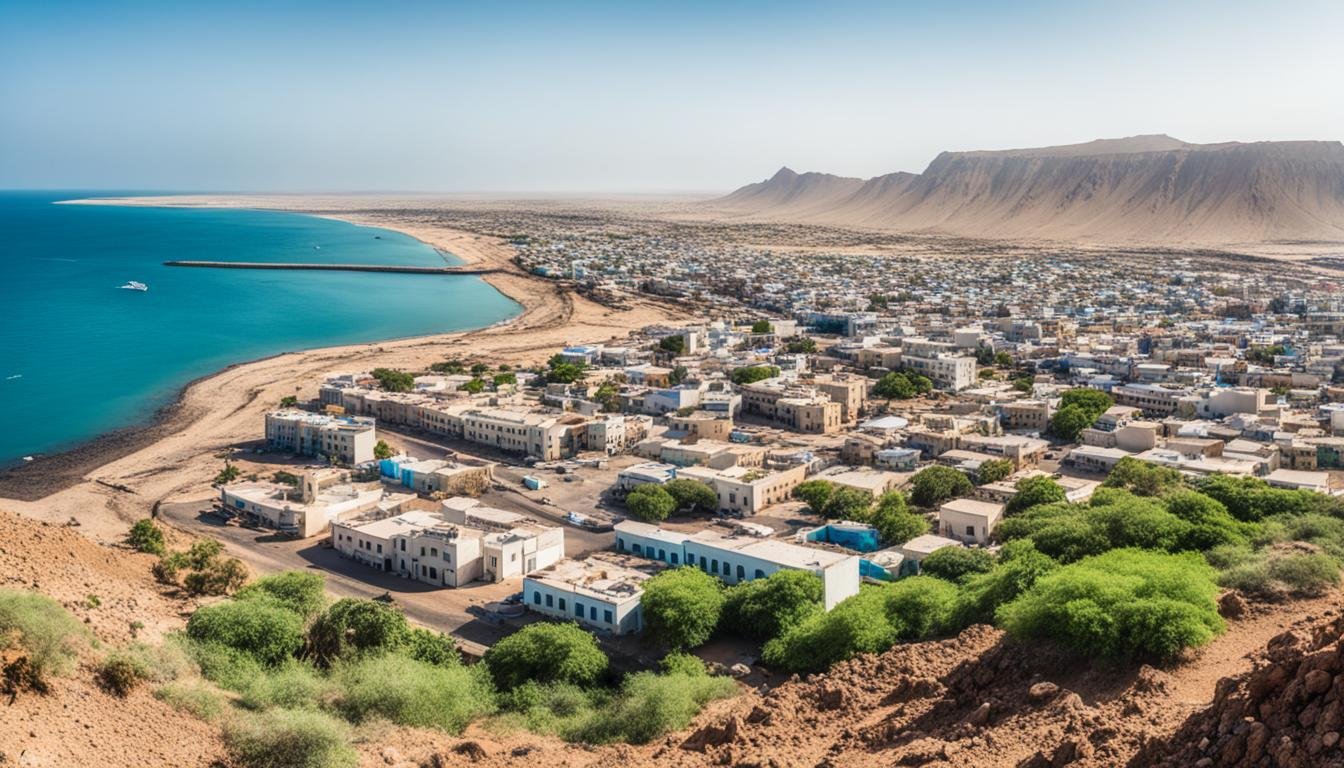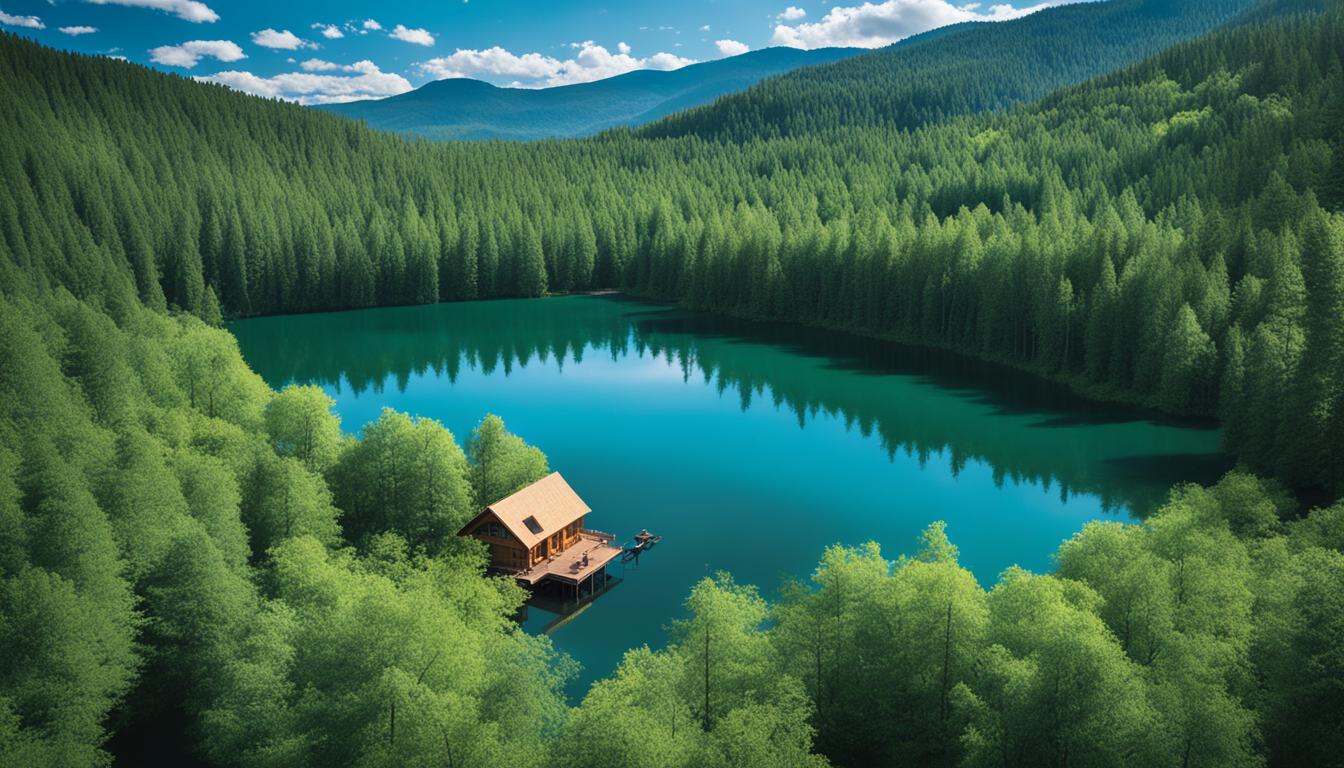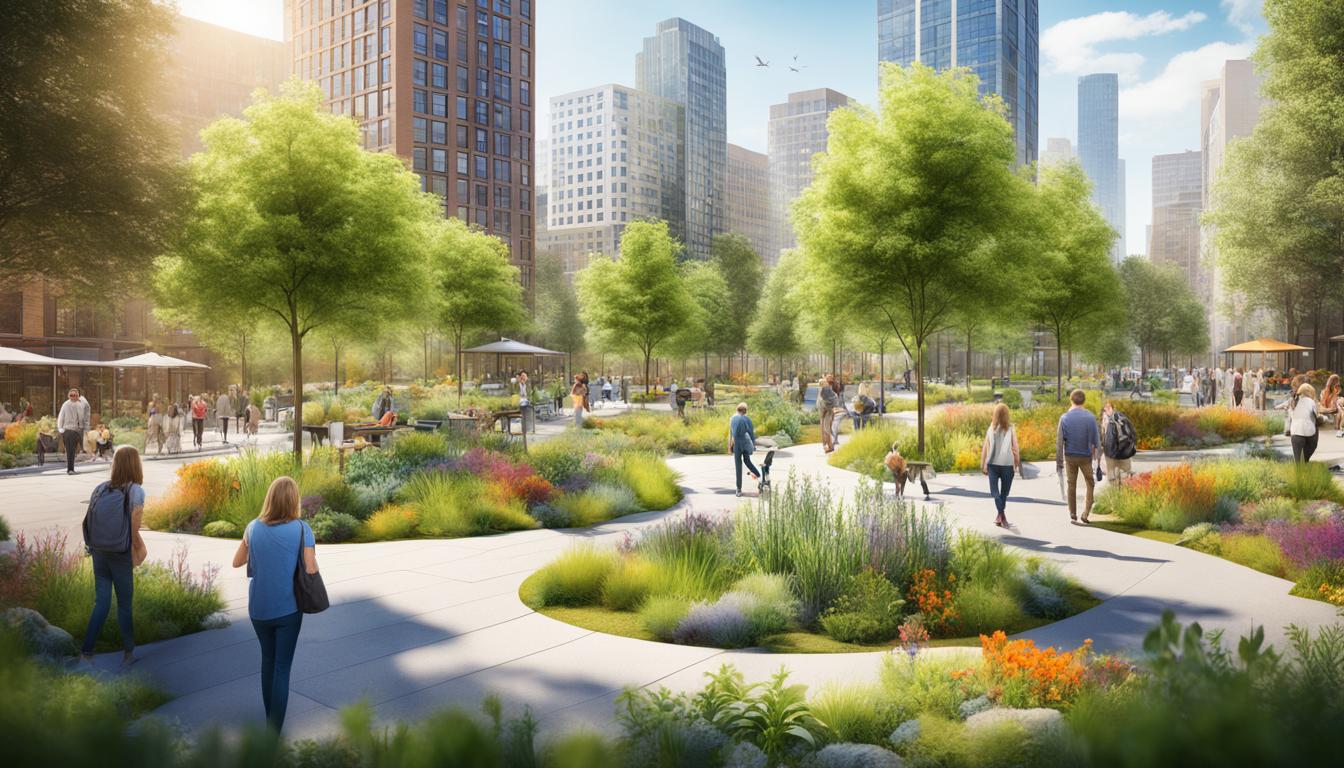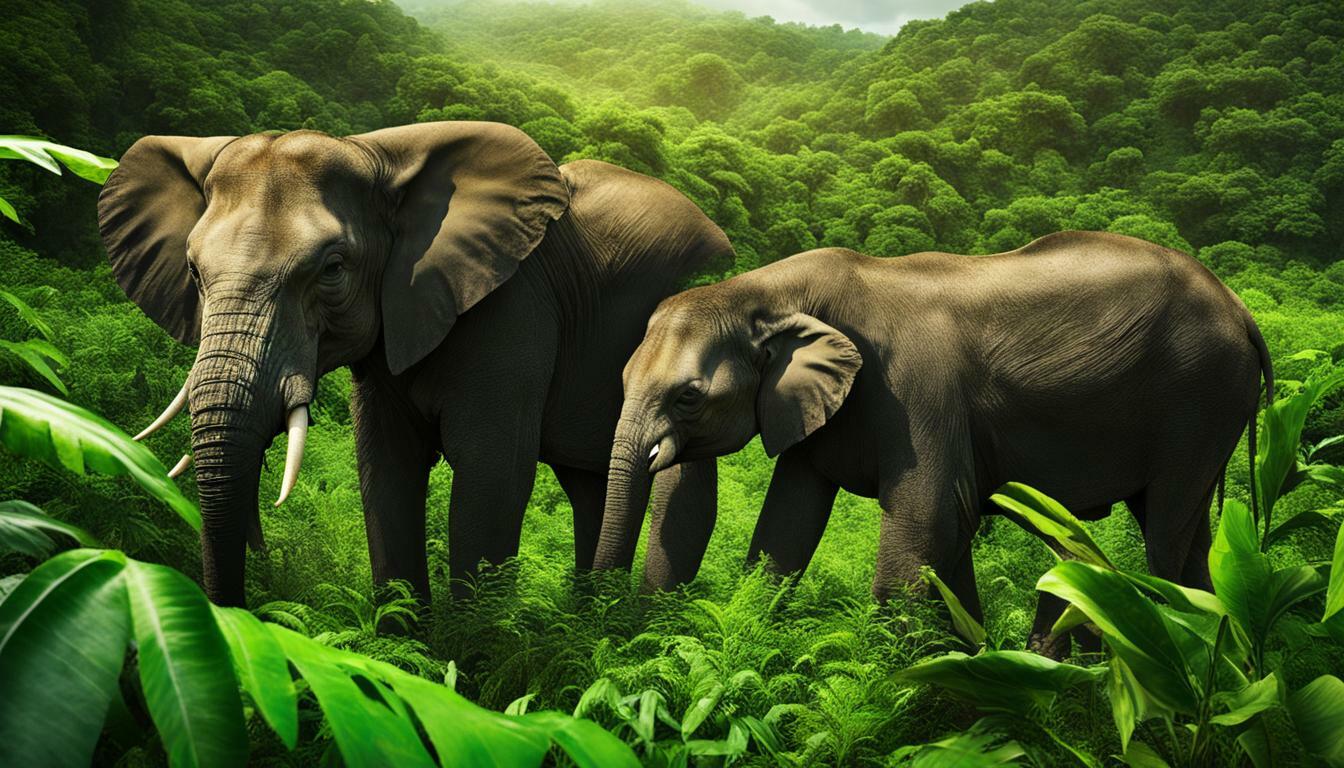Dominican Republic Biodiversity and the Built Environment
The Dominican Republic is renowned for its breathtaking natural beauty and ecological diversity. From lush rainforests to stunning coastlines, the country is a treasure trove of unique ecosystems and species. However, rapid urban development and other human activities have put these invaluable natural resources at risk.
In this article, we will explore the intersection of biodiversity and the built environment in the Dominican Republic. We will delve into the sustainable development initiatives, conservation efforts, and urban planning strategies that aim to preserve the country’s natural heritage while accommodating the needs of its growing population.
As we delve into this topic, we will examine the importance of ecological diversity in the Dominican Republic and the urgent need to protect it. We will also explore sustainable architecture practices, the significance of environmental impact assessments, and various ecosystem management strategies that contribute to maintaining a harmonious balance between the built environment and nature.
Key Takeaways:
- The Dominican Republic is home to a diverse range of ecosystems and species
- Conservation efforts and urban planning initiatives are crucial for preserving the country’s natural heritage
- Sustainable architecture practices and environmental impact assessments play a significant role in minimizing the ecological footprint
- Ecosystem management strategies and green infrastructure planning are essential for maintaining a symbiotic relationship between the built environment and biodiversity
- Preserving the Dominican Republic’s natural resources is vital for sustainable development and the well-being of both nature and people
Ecosystem Diversity in the Dominican Republic
The Dominican Republic boasts a remarkable level of ecosystem diversity, encompassing eight distinct terrestrial ecosystems and a multitude of coastal and marine environments. These diverse ecosystems provide a vibrant habitat for a wide range of species, many of which are found only in this beautiful Caribbean country. The richness of endemic species found in the Dominican Republic is a testament to its unique biodiversity.
Endemic Species Hotspots
Several regions within the Dominican Republic are considered hotspots of endemic plant and animal species. Among these, the Sierra de Bahoruco, Barbacoa-Casabito subregion, and Sierra de Neiba stand out for their exceptional concentration of endemic flora and fauna. These areas play a critical role in the conservation of species found nowhere else on Earth, making them high-priority sites for biodiversity preservation.
The Critical Ecosystems Partnership Fund has identified 35 Key Biodiversity Areas (KBAs) in the Dominican Republic, covering approximately 18% of the country’s land area. These KBAs are globally significant sites that require high-priority conservation measures to protect their unique biodiversity.
| Key Biodiversity Areas | Region | Endemic Species |
|---|---|---|
| Sierra de Bahoruco | Barahona and Pedernales provinces | 189 plant species, 6 bird species, 2 reptile species |
| Barbacoa-Casabito subregion | Dominican Republic’s Central Mountain Range | 112 plant species, 2 bird species, 5 reptile species |
| Sierra de Neiba | Independencia and Bahoruco provinces | 80 plant species, 3 bird species, 4 reptile species |
These high-priority conservation sites are crucial for safeguarding the Dominican Republic’s rich and unique biodiversity. By focusing on preserving these areas, we can protect the species that make this country so special and contribute to the global efforts of biodiversity conservation.
Threats to Biodiversity in the Dominican Republic
The rich biodiversity of the Dominican Republic is currently facing a range of threats that put its ecosystems and species at risk. These threats are predominantly caused by human activities, such as habitat loss, climate change, and the introduction of invasive species. The impacts of these anthropogenic pressures are exacerbated by the intrinsic vulnerability of many plant and animal species in the region.
Habitat Loss
One of the primary biodiversity threats in the Dominican Republic is habitat loss. The expansion of agricultural and livestock activities, along with the development of tourism infrastructure and mining operations, has led to the loss and fragmentation of natural habitats. This has resulted in the decline of ecosystems, such as broad-leaved cloud forests, which have significantly decreased in extent over time.
Species Extinction
The loss of habitat and the disruption of ecological processes have put numerous species at risk of extinction. Both vertebrates and vascular plants in the Dominican Republic face the threat of disappearing forever. These species are particularly vulnerable due to their restricted ranges and specialized adaptations to specific habitats. Without effective conservation measures, the loss of these unique species would result in a significant loss of biodiversity.
Anthropogenic Pressures
Anthropogenic pressures, including habitat destruction, pollution, and overexploitation of natural resources, represent significant threats to the biodiversity of the Dominican Republic. These activities disrupt the balance of ecosystems, leading to the decline and potential extinction of species. Urgent action is required to mitigate these pressures and ensure the long-term survival of the region’s diverse flora and fauna.
Climate Change
Climate change further exacerbates the threats to biodiversity in the Dominican Republic. Rising temperatures, changing precipitation patterns, and increased frequency of extreme weather events directly impact ecosystems and species. Shifts in temperature and rainfall regimes disrupt the delicate balance of ecosystems, leading to shifts in species distributions and potential extinctions. The effects of climate change on biodiversity are complex and require comprehensive strategies to mitigate and adapt to these impacts.
Invasive Species
The introduction of invasive species poses a significant threat to the native biodiversity of the Dominican Republic. Invasive species, which are introduced by human activities, outcompete native species for resources, disrupt ecological interactions, and alter ecosystem processes. This results in the decline and displacement of native species, leading to the loss of functional diversity and ecosystem stability.
“The loss of biodiversity in the Dominican Republic due to different threats is a matter of urgent concern. To preserve the unique ecosystems and species in the region, it is crucial to address the underlying causes of these threats and implement effective conservation strategies.”
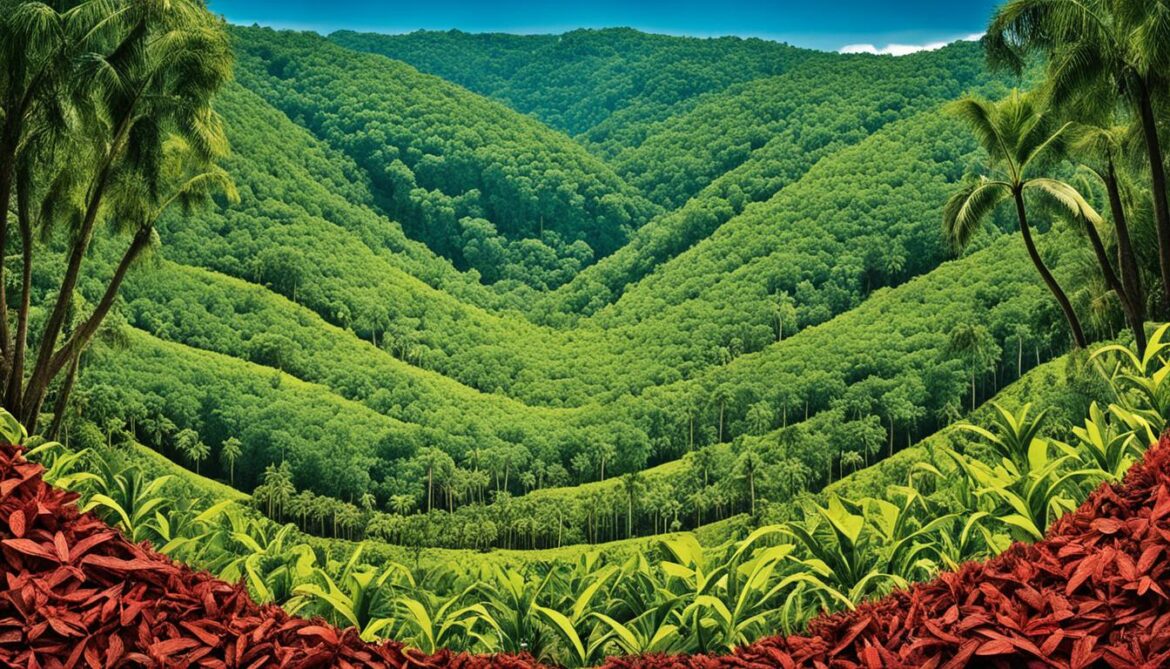
| Threat | Impact |
|---|---|
| Habitat loss | Disruption of ecosystems, loss of critical habitats |
| Species extinction | Irreversible loss of unique species |
| Anthropogenic pressures | Disruption of ecological balance, decline of species |
| Climate change | Shifts in species distributions, potential extinctions |
| Invasive species | Displacement of native species, loss of ecosystem stability |
Conservation Efforts in the Dominican Republic
The Dominican Republic is committed to the conservation of its diverse biodiversity through various initiatives and programs. These efforts aim to protect and preserve the country’s natural heritage, ensuring the long-term sustainability of its ecosystems and species.
The National System of Protected Areas
One of the key conservation strategies in the Dominican Republic is the establishment of protected areas. The National System of Protected Areas covers 25% of the country’s territory, encompassing both terrestrial and marine environments. These protected areas serve as havens for numerous plant and animal species, safeguarding their habitats and promoting biodiversity conservation.
Sustainable Fishing Practices
In recognition of the importance of marine resources, the Dominican Republic has implemented sustainable fishing practices. These practices include regulations on fishing methods, catch limits, and size restrictions to ensure the responsible management of marine resources. By promoting sustainable fishing practices, the country aims to protect fish populations and maintain a healthy marine ecosystem.
Caribbean Challenge Initiative
The Dominican Republic actively participates in the Caribbean Challenge Initiative, a regional effort to conserve nearshore marine and coastal environments. The initiative’s goal is to protect at least 20% of these areas by 2020. Through collaboration with other Caribbean nations, the Dominican Republic is working towards the effective management and conservation of its marine resources, including coral reefs, mangroves, and other vital coastal ecosystems.
“The conservation efforts in the Dominican Republic are crucial for preserving the country’s natural heritage and supporting sustainable development. By protecting biodiversity and implementing sustainable practices, we can ensure a harmonious coexistence between humans and nature.” – Environmental Conservation Expert
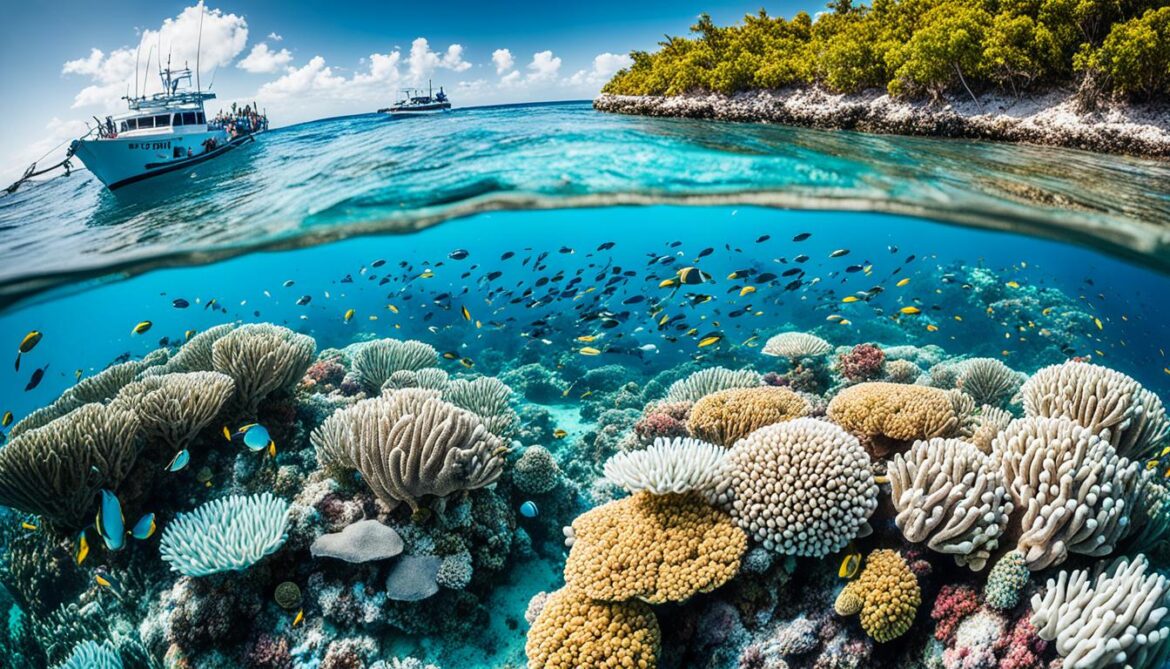
The conservation efforts in the Dominican Republic are guided by a commitment to safeguarding the country’s natural treasures. Through the establishment of protected areas, the implementation of sustainable fishing practices, and active participation in regional initiatives, the Dominican Republic is taking significant steps towards preserving its biodiversity for future generations.
Water Conservation in the Dominican Republic
The Dominican Republic is currently facing freshwater scarcity, a significant challenge that requires effective conservation strategies to ensure the sustainability of this vital resource. To address this issue, the Conservancy has introduced Water Funds, a groundbreaking approach to water conservation.
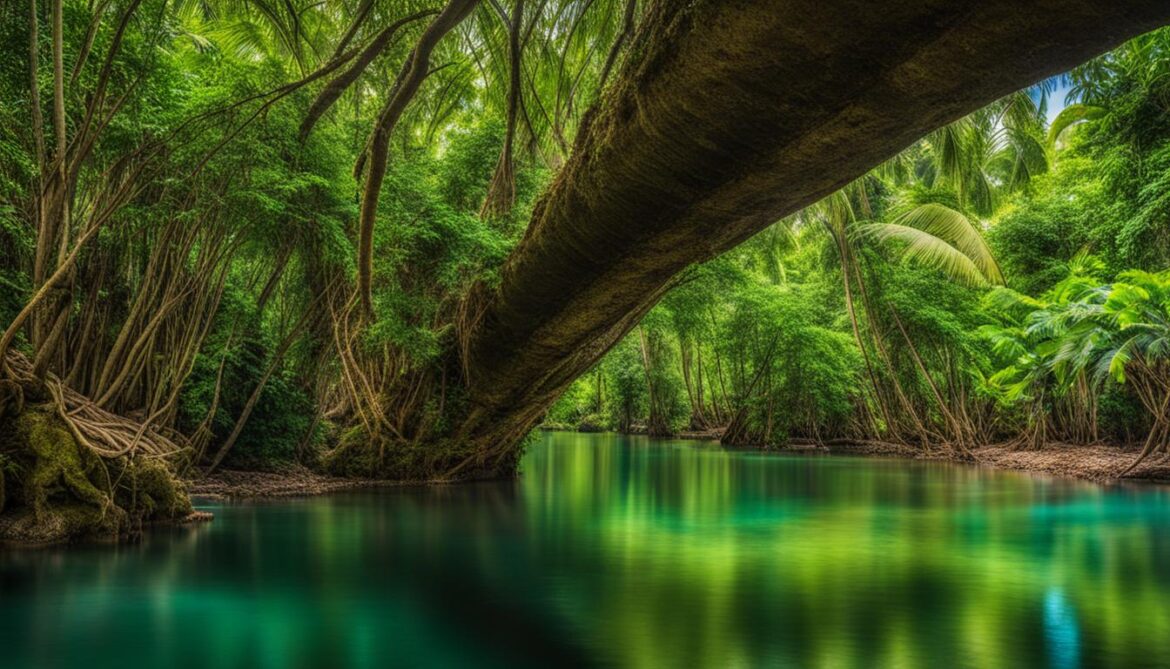
The Water Funds initiative aims to secure funds from downstream water users and redirect them towards conservation efforts in critical watersheds that supply water to a substantial portion of the population. These funds are then utilized for various projects and initiatives, including reforestation, management of protected areas, and the implementation of water conservation measures.
By investing in upstream conservation, the Water Funds program helps protect and restore the natural systems that produce and filter water, safeguarding the quality and quantity of freshwater resources. This comprehensive approach not only ensures the availability of clean drinking water for millions of Dominicans but also supports the ecological health and resilience of watersheds.
“The Water Funds initiative is a powerful tool for watershed management and resilience-building. By involving downstream water users in conservation efforts, we can create a sustainable future for both people and nature.” – [Replace with a relevant quote from a conservation expert or government official]
Through the implementation of the Water Funds program, the Dominican Republic is taking proactive steps towards water conservation and sustainable natural resource management. This innovative approach demonstrates the importance of upstream conservation in mitigating freshwater scarcity and promoting watershed health.
Here is a break down of the key projects and initiatives supported by Water Funds:
River Reforestation:
Reforestation projects are carried out in the upper reaches of key rivers to restore riparian vegetation and prevent soil erosion. These efforts help to maintain the natural hydrological cycle and preserve water quality.
Protected Areas Management:
The Water Funds program supports the effective management of protected areas located in critical watersheds. This includes the establishment of buffer zones, the enforcement of regulations, and the implementation of monitoring and conservation programs.
Water Conservation Initiatives:
Water Funds contribute to the implementation of various water conservation initiatives, such as the promotion of efficient irrigation practices, the installation of rainwater harvesting systems, and the education of local communities on the importance of water stewardship.
The table below provides an overview of the activities supported by the Water Funds program:
| Water Funds Initiatives | Description |
|---|---|
| River Reforestation | Reforestation of key river areas to prevent soil erosion and maintain water quality. |
| Protected Areas Management | Support for the effective management of protected areas within critical watersheds. |
| Water Conservation Initiatives | Implementation of water-saving initiatives, such as promoting efficient irrigation and rainwater harvesting. |
The Water Funds program in the Dominican Republic represents a remarkable approach to water conservation, addressing the challenges of freshwater scarcity and promoting sustainable watershed management. By investing in upstream conservation, the country is safeguarding its freshwater resources for future generations while nurturing the interconnected ecosystems that rely on these vital water sources.
Coastal and Marine Conservation in the Dominican Republic
The Dominican Republic has demonstrated commendable leadership in the conservation of its coastal and marine environments. As part of its commitment to preserving these invaluable natural resources, the country actively participates in the Caribbean Challenge Initiative.
Through the establishment of marine protected areas, the Dominican Republic has significantly contributed to the National System of Protected Areas. These protected areas play a crucial role in safeguarding diverse coastal ecosystems, including coral reefs, mangroves, and other marine habitats that support a wide range of biodiversity.
To ensure the long-term sustainability of marine resources, the country is also taking strides towards promoting sustainable fishing practices. By implementing responsible fishing techniques and adopting science-based conservation measures, the Dominican Republic aims to protect the delicate balance of its fisheries. This approach not only safeguards important marine species but also safeguards the livelihoods of those who depend on them.
By prioritizing coastal conservation and the protection of marine habitats, the Dominican Republic showcases its commitment to preserving its natural heritage for future generations. Through the Caribbean Challenge Initiative and sustainable fisheries practices, the country is making significant progress in ensuring the sustainability of its coastal and marine environments.
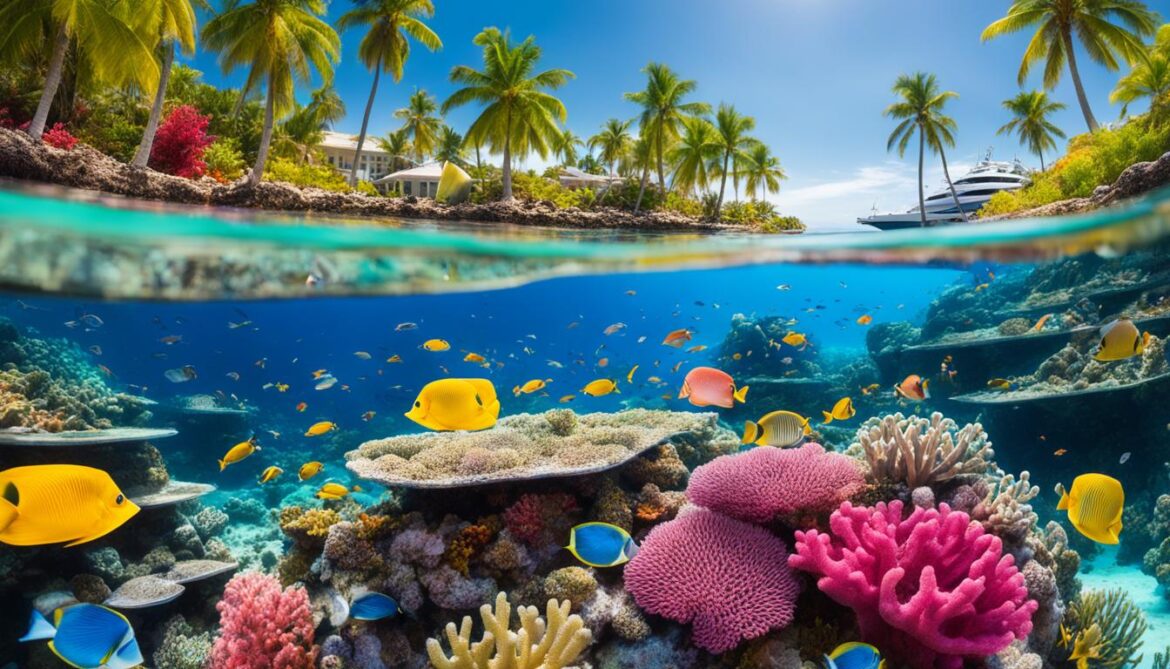
Sustainable Architecture and Urban Planning in the Dominican Republic
The Dominican Republic is committed to implementing sustainable architecture and urban planning practices that prioritize the harmony between built environments and biodiversity. Through green infrastructure planning, the country aims to enhance the sustainability of urban development projects, ensuring a balance between urbanization and environmental preservation.
As part of this commitment, rigorous environmental impact assessments are conducted to assess the potential consequences of development activities. These assessments help identify and mitigate any negative environmental impacts, allowing for the integration of sustainable design principles in urban development.
Sustainable architecture and urban design techniques minimize the ecological footprint of buildings and urban areas, promoting energy efficiency, waste reduction, and the use of renewable materials. By adopting green building standards and implementing innovative urban design strategies, the Dominican Republic aims to create vibrant and sustainable cities that support both the well-being of residents and the conservation of natural resources.
“Sustainable architecture and urban planning are essential for creating resilient and environmentally friendly cities that fulfill the needs of present and future generations.” – Juan Perez, Sustainable Architect
Sustainable architecture in the Dominican Republic incorporates elements such as passive design strategies, green roofs, solar panels, and efficient water management systems. These features promote a more sustainable built environment and contribute to reducing energy consumption and greenhouse gas emissions.
Furthermore, green infrastructure planning focuses on the incorporation of natural elements, such as parks, green spaces, and urban forests, into urban areas. This approach not only enhances the aesthetic appeal of cities but also provides numerous benefits, including improved air quality, biodiversity conservation, and climate change mitigation.
Benefits of Sustainable Architecture and Urban Planning
- Promotes energy efficiency and reduces carbon emissions
- Enhances the quality of life for residents through improved indoor air quality and access to green spaces
- Preserves and protects natural resources
- Reduces urban heat island effects
- Supports biodiversity conservation
- Increases resilience to climate change impacts
- Fosters sustainable economic development
The integration of sustainable architecture and urban planning principles in the Dominican Republic showcases the country’s commitment to addressing environmental challenges while creating livable and sustainable cities. By prioritizing the coexistence of the built environment and biodiversity, the Dominican Republic is paving the way for a more sustainable future.

The Role of Communities in Biodiversity Conservation
Local communities have a vital role to play in biodiversity conservation in the Dominican Republic. Recognizing this, conservation organizations like The Nature Conservancy work closely with communities to raise awareness about the importance of protecting biodiversity and the ecosystems that sustain them.
Through community engagement initiatives, the focus is on promoting sustainable livelihoods that depend on natural resources, while empowering local residents to actively participate in conservation efforts. By involving communities, conservation efforts can be more effective, ensuring the long-term preservation of the Dominican Republic’s rich biodiversity.
Conservation Awareness
Raising conservation awareness is a key aspect of community involvement. Through educational programs, workshops, and outreach activities, organizations collaborate with local communities to foster a deep understanding of the value of biodiversity and the need for conservation. By empowering individuals with knowledge, they become passionate advocates for preserving their natural heritage.
Sustainable Livelihoods
Community involvement in biodiversity conservation also focuses on promoting sustainable livelihoods. This approach recognizes the interconnectedness between humans and nature, highlighting the importance of balancing ecosystem protection with the well-being of local communities. By promoting sustainable practices such as agroforestry, organic farming, and eco-tourism, communities can maintain their way of life without depleting natural resources.
“Local communities are the guardians of their natural ecosystems. By engaging them, we can protect biodiversity while improving lives and building resilient communities.” – The Nature Conservancy
Effective and Sustainable Conservation
By actively involving communities in biodiversity conservation, efforts become more effective and sustainable. Local residents gain a sense of ownership and responsibility for their natural surroundings, ensuring continued stewardship for generations to come. Community involvement also fosters a sense of pride in the unique biodiversity of the Dominican Republic, promoting a culture of conservation and ecological sustainability.
The Power of Collaborative Action
Collaboration between conservation organizations, government agencies, and local communities is essential for successful biodiversity conservation. By working together, these stakeholders can combine their expertise, resources, and knowledge to implement conservation strategies that address both ecological and socio-economic needs.
| Benefits of Community Involvement | Examples |
|---|---|
| Promotes local engagement | – Community-led reforestation projects – Community-based ecotourism initiatives |
| Strengthens conservation awareness | – Environmental education programs – Awareness campaigns |
| Supports sustainable livelihoods | – Organic farming cooperatives – Sustainable fishing practices |
| Fosters long-term commitment | – Community-led monitoring and enforcement – Participatory decision-making processes |
By harnessing the power of community involvement, we can create a future where biodiversity conservation, local communities, and sustainable livelihoods thrive hand in hand.
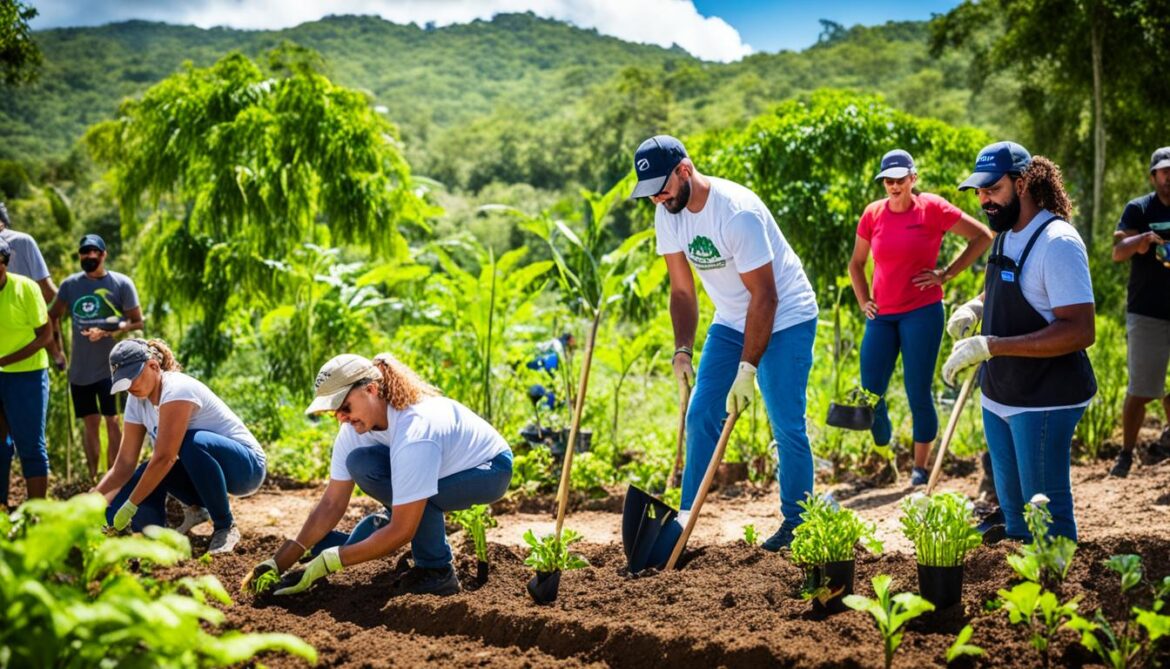
Conclusion
In conclusion, the Dominican Republic is home to a remarkable array of ecosystems and species that are of global importance for conservation. However, these invaluable natural resources face significant threats from human activities such as habitat loss, climate change, and the introduction of invasive species. To combat these challenges and ensure the long-term sustainability of biodiversity, it is crucial to prioritize conservation efforts.
The establishment of protected areas, such as the National System of Protected Areas, plays a vital role in safeguarding the country’s diverse ecosystems. These protected areas provide a safe haven for endemic species and contribute to the preservation of natural heritage. Additionally, sustainable fishing practices and the promotion of community involvement are essential components of biodiversity conservation in the Dominican Republic.
Furthermore, sustainable architecture and urban planning practices can contribute to the harmonious coexistence of the built environment and biodiversity. By integrating green infrastructure planning, conducting environmental impact assessments, and adopting sustainable design principles, we can minimize the negative impact of urban development on natural ecosystems.
Overall, the conservation of biodiversity in the Dominican Republic is of utmost importance. By implementing effective strategies and engaging local communities, we can ensure a sustainable future for both nature and people. It is our responsibility to protect and preserve the remarkable ecological diversity that the Dominican Republic offers for generations to come.




